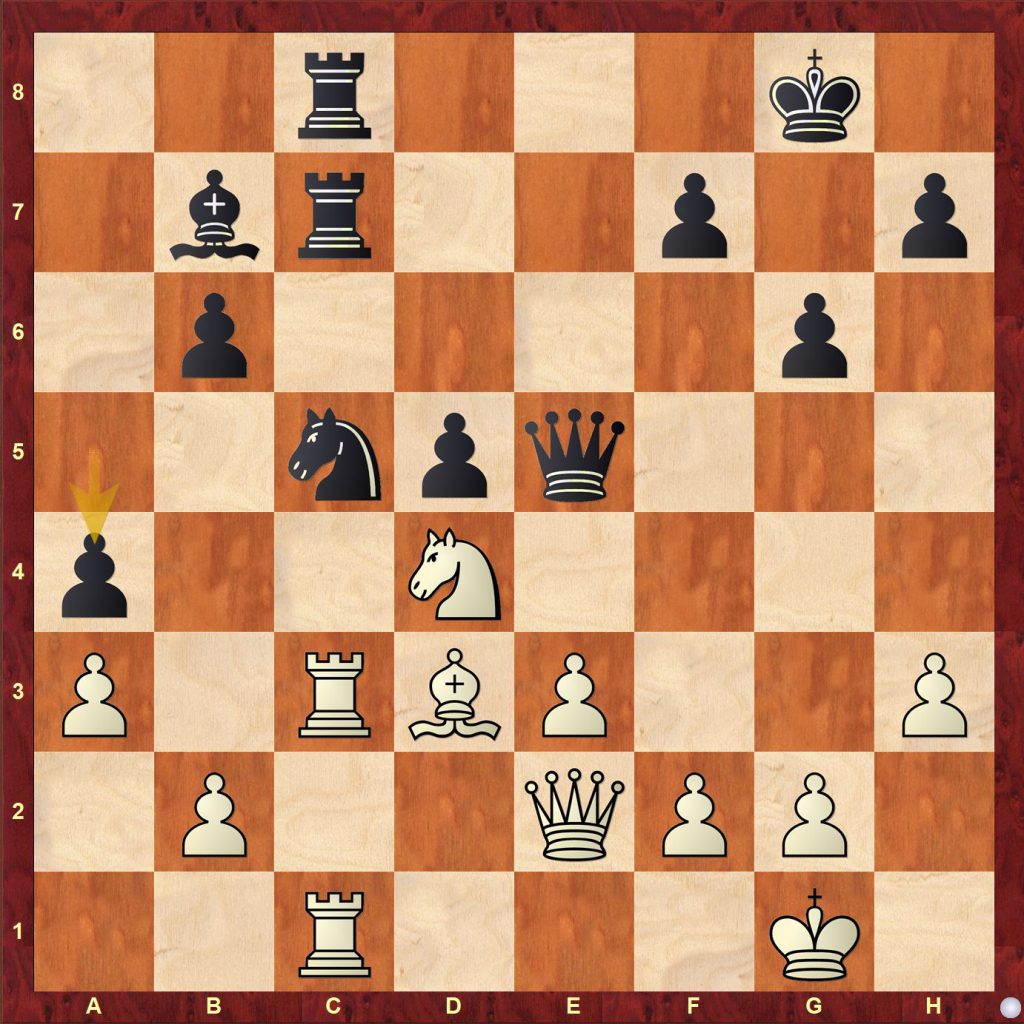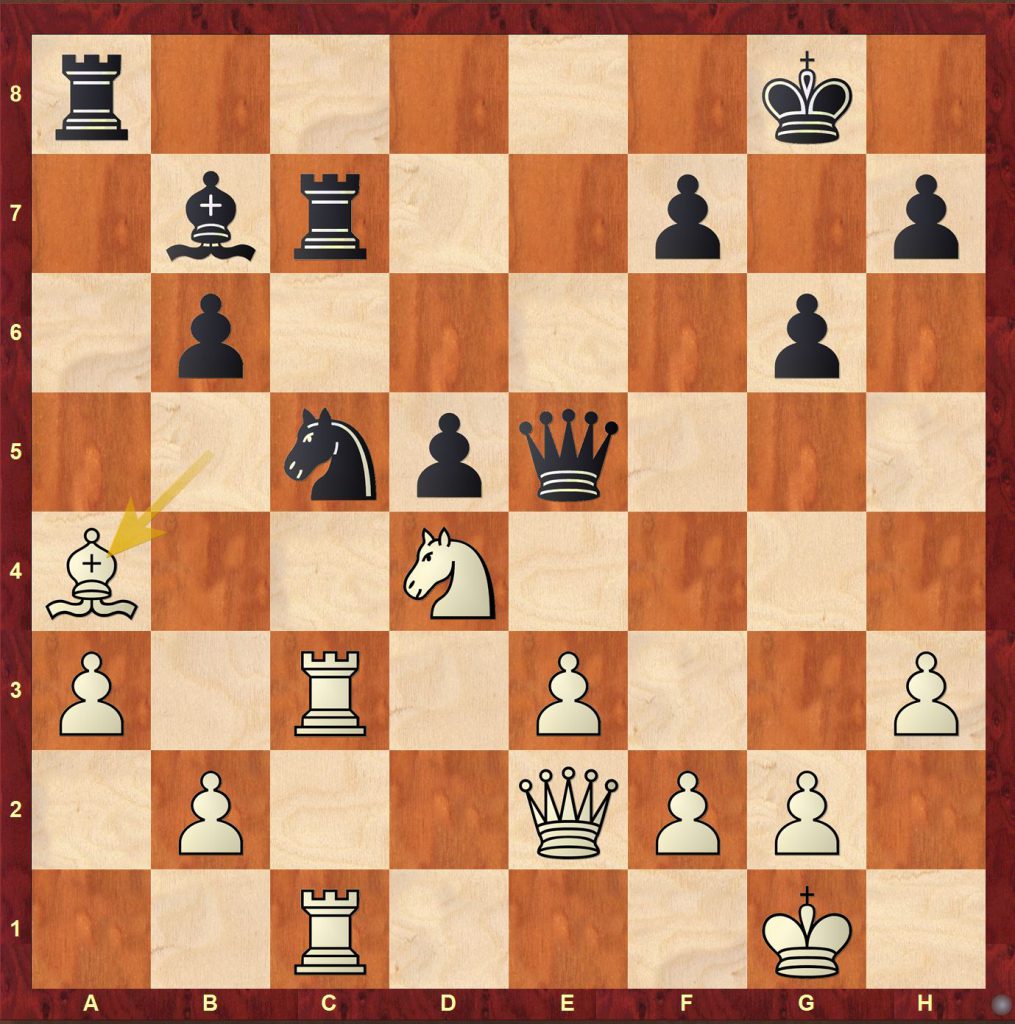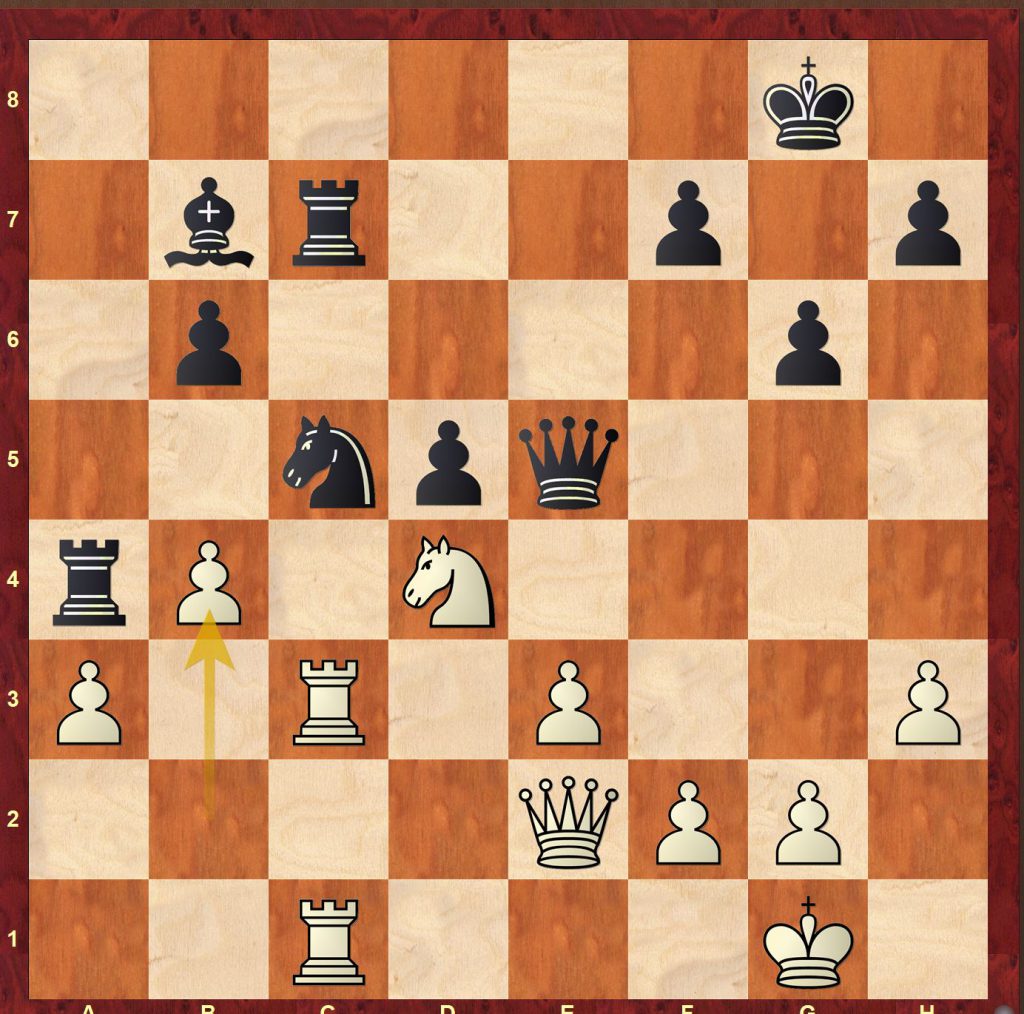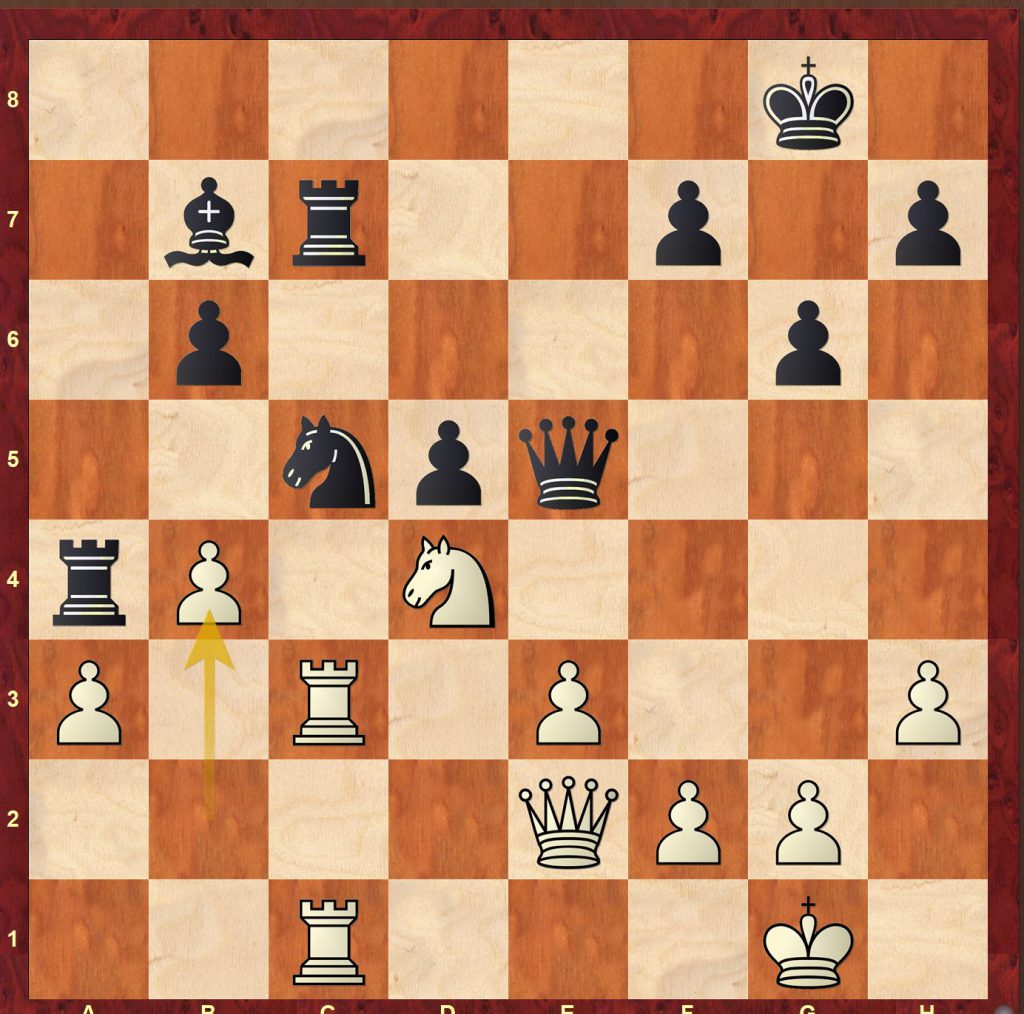After winning their first encounter, Frank Marshall had to wait another 40 years to defeat Emanuel Lasker! This game was played 6 months before Lasker’s death at an exhibition match played next to the 1940 US Championship. It was a very interesting game with a fraught tactical episode on the 23rd move. I think that Lasker in his prime would have exploited the saving opportunity that Marshall gave him, but here Marshall’s trickiness was just enough to get him his long-awaited victory!
A video of this article is also available at https://www.youtube.com/watch?v=57JDBisizH0 As always, a playable version of this game is available at http://cloudserver.chessbase.com/MTIyMTYx/replay.html
Marshall,Frank James – Lasker,Emanuel [D62]
Match Marshall-Lasker,Em +1–0=1 New York, 18.05.1940
[https://matthewsadler.me.uk]
1.c4
[Marshall commented in his book of selected games: “We contested the following game at the Astor, in the playing enclosure in which the US Championship was taking place. I am sure that that gallant warrior must have shared my feelings, as I looked at today’s youthful stars – Reshevsky, Fine and all the others, and thought of all the old tournaments in which we had had so many stirring encounters, and all our famous rivals: Pillsbury, Tarrasch, Janowsky and so many others… they are only memories now”]
1…e6 2.Nf3 Nf6 3.Nc3 d5 4.d4 Nbd7 5.Bg5 Be7 6.e3 0–0 7.Qc2 c5 8.cxd5 Nxd5 9.Bxe7 Qxe7 10.Nxd5 exd5 11.Bd3 g6 12.dxc5 Nxc5 13.0–0 b6 14.Rac1 a5 [Not the most common plan, but a sensible approach: the knight on c5 blocks White’s play until Black is ready to challenge for the c-file while the queenside pawns are well-placed on the opposite colour to the light-squared bishop (following Capablanca’s famous maxim). As Marshall points out, Black also has the threat of 15…Nxd3 followed by …Ba6 netting the exchange.]
15.Rfd1 Bb7 16.Nd4 Rfc8 17.Qe2 Qf6 18.h3 Rc7 19.Rc3 Rac8 20.Rdc1 Qe5 21.a3

[Hinting at b4, driving away the knight from c5.]
21…a4

[Strangely enough a serious error. The crux of Black’s play has been to maintain the knight on c5 for long enough to be able to neutralise White’s play with exchanges on the c-file. 21…Ne6 would be completely acceptable for Black. As long as Black’s queenside pawns are on dark squares, then White will struggle to make anything of the resulting IQP ending, even with a good bishop against a bad bishop. By playing 21…a4, Black roots the knight to c5 and commits Black to never play any ending due to the enormous target of the pawn on a4. Even worse, there are some immediate tactical opportunities.]
22.Bb5 [intending Qd1 or Qc2, targeting the a4–pawn.]
22…Ra8 [This incautious move gives White an unexpected opportunity to immediately exploit the new weakness.]
[22…Nb3 23.Rxc7 Rxc7 24.Rxc7 Nxd4 25.exd4 Qxc7 26.Qd2 (26.Bxa4 Qc1+ 27.Bd1 This was Marshall’s line 27…Ba6 28.Qc2 Qf4 29.Qc3 is also fine, but the text is safer.) ]
23.Bxa4

23…Rxa4 24.b4

[This tactic is much more fraught than it looks at first sight: White is not yet threatening to capture the knight on c5 due to …Rxd4, so White will require an unpinning move. The plus side is that White has quite a few of them: Qb5, Qc2, Qd1 and Qb2 and these all introduce subsidiary threats that are hard to cope with.]
24…Qe8
[24…Nb3 25.Rxc7 Nxc1 (25…Nxd4 26.Qd1 was Marshall’s line) 26.Qc2 also mentioned by Marshall, though there are still a few more tricks left in the position. 26…Rxa3 (26…Ba6 27.Qxc1 Bc4 28.Rc8+) 27.Rxb7 Ra1 (27…Ne2+ 28.Nxe2 Ra1+ 29.Nc1) 28.Qc8+ Kg7 29.Ne6+ Kh6 (29…Kf6 30.Qh8+ Kxe6 31.Re7+) 30.Qf8+ Kh5 31.g4+ Kh4 32.Qh6+;
24…Ne6 25.Rxc7 Nxc7 (25…Nxd4 26.Qd1 hits everything!) 26.Qc2 Rxa3 27.Qxc7 Qxc7 28.Rxc7 and the light-squared bishop will never escape its box!;
24…Rc8 25.Qb5 (25.bxc5 Rxd4 26.c6 Rxc6 (26…Ba8 27.Qa6) 27.Rxc6 Bxc6 28.Rxc6 Rc4 29.Rxc4 dxc4 30.Qxc4 Qa1+ secures equality for Black.) 25…Qe8 (25…Ba6 26.Qxb6) 26.Qxe8+ Rxe8 27.bxc5 bxc5 28.Rxc5 Rxa3 29.Rc7 Ba6 30.Ra7 is awful for Black.]
25.Qc2

[A poor move, throwing away most of White’s advantage though Marshall makes no comment about it.]
[25.bxc5 Rxd4;
25.Qb2 with an X-Ray attack on the bishop on b7. 25…Qe7 26.bxc5 bxc5 27.Qb5 Rc4 28.Rxc4 dxc4 29.Qxc4 (29.Ne2 is another engine suggestion, to meet 29…Qg5 with 30.Nf4) 29…Qg5 rather worried me. 30.Qf1 The engine defence which I had missed. However, it all looks a bit uncomfortable for White. (30.g3 cxd4 31.Qxc7 Qd5 32.f3 Qxf3 33.Qb8+ Kg7 34.Qe5+ Kg8 seemed drawn to me, and the engine agrees.) ; 25.Qd1 Qd7 26.bxc5 bxc5 27.Rxc5 Rxc5 28.Rxc5 Rxa3 29.Qc1 looks simple and very unpleasant for Black again (just like 25.Qb5). Black is bound to lose the f-pawn somehow and end up in a cheerless endgame.;
25.Qb5 My favourite idea 25…Qxb5 26.Nxb5 Rd7 (26…Rc8 27.Nd6) 27.bxc5 bxc5 28.Rxc5 Ba6 (28…Ra5 29.R1c3) 29.Nc3 Rxa3 30.Nxd5 is a clear advantage for White: Black will struggle to draw.]
25…Re7 [A complete blunder: it’s hard to understand what Lasker missed.]
[25…Ra8 is much stronger. 26.Qb1 (26.bxc5 bxc5 Threatening to consolidate with …c5–c4. 27.Rxc5 Rxc5 28.Qxc5 Rc8 is the point, picking up the rook on c1.) 26…Qe7 holds everything for Black.]
26.bxc5 bxc5 27.Rxc5 Rxe3 [27…Rxa3 28.Qb2 Qa4 (28…Ra8 29.Nb5 Marshall “with a winning game” which is a little over the top, though Black stands very unpleasantly) 29.Rc8+ Bxc8 30.Rxc8+ Kg7 31.Nf5# is Marshall’s gallery-finish line!]
28.fxe3 Qxe3+ 29.Qf2 Qxd4 30.Qxd4 Rxd4 31.Ra5 Rc4 32.Rxc4 dxc4 33.Rc5 Ba6 34.a4 1–0



